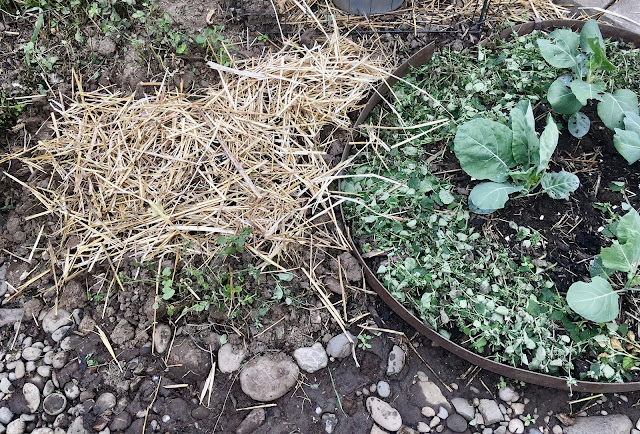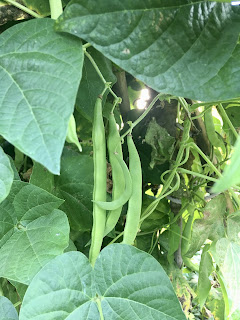October is often wet here in our valley, and finally the weather is starting to cool off, so I face the challenge of the lure of hibernation: I'd rather not garden in the rain!
But if I can be strong, get on my rain gear, and take a daily tour of my garden, I find many simple things to do, without getting too muddy!
The best tip I've read in any permaculture blog Is this: Be consistent with 15-minutes a day, year round. I try to take a 15-minute walk through my garden each day, and I alternate the front and back gardens so I don't feel rushed.
Agenda:
1. October harvest
1. October harvest
2. Save seeds
3. October garden care and bedding down
4. Fall planting
5. Raspberry pruning and thinning
1. October harvest:
 All year, your most important task in the garden is to harvest AND USE what you’ve already grown, or share it with others. And it's the easiest thing to do, even in rain gear. I accept the harvest with wonder and thanksgiving.
All year, your most important task in the garden is to harvest AND USE what you’ve already grown, or share it with others. And it's the easiest thing to do, even in rain gear. I accept the harvest with wonder and thanksgiving.I'm STILL picking beans, and occasional summer squash, pumpkins, tomatoes, cucumbers, leeks, beets, and rhubarb.
And yesterday we finally picked all our grapes and made juice!
2. Save seeds:
And of course I'm harvesting seeds. Today I've collected handfuls of beans still in the pod to dry for seed, leek seed heads, and more milkweed pods.
Leek seeds are black and small, like onion seeds. I've left them on the stalk all summer, and a little past the best time to harvest - the flower head should be papery. (To prevent losing your seed to the ground while it dries in the summer, you can rubber band a small paper or muslin bag over the flower head so seed will fall inside your bag instead of onto the ground.) Or you can cut the stalks and bring them inside when you notice the seeds are dark and the flowers have faded. Invert your cut stalks and place them, head first, into a paper bag to hang them in a well ventilated place to finish drying. |
| Leek seed heads and milkweed pods |
They need to dry for at least a week. Once they are dry I will put them into labeled envelopes, and store all my seeds in a zip-lock bag in the refrigerator, near the bottom, away from the freezer. (Note to self: Next spring, take bags out but keep them closed until the seeds warm, so moisture in the air doesn’t condense on the seeds.)
3. October garden care and bedding down:
In October, after harvesting, I'm mostly putting beds to rest, called bedding down: Some garden beds get to truly rest for a spell, and this is my last chance to prepare the soil for winter, and for planting next spring, weed free and "packed full of nutrients".
 |
| Mulch: Straw over winter garlic and chopped lemon balm around my Brussels sprouts |
In summer, mulch retains moisture and prevents weeds. In winter, mulch protects against erosion from heavy rains, and stabilizes the soil temperature. (If I still have plants growing, I keep mulch at least an inch away from the plant stems.)
Green cover crops (live plants) also make good mulch and add nutrients. I'ill plant a cover crop of fava beans or clover in some of the empty beds. Later I will cut them back and put the plants on the beds as mulch, to allow the nitrogen to leech into the soil.
I've still got a few fall planting tasks. This is the month to plant garlic, spring bulbs, and many native seeds and plants (as well as cover crops).
Garlic (Allium sativum L) is one of the world’s oldest cultivated crops. Scientists debate its origin: It's a native of central or South Asia, or perhaps southwestern Siberia. Garlic lovers carried the pungent herb into Egypt, Pakistan, India and China. The crusaders brought it back to Europe.
Besides being used in almost every cuisine of cooking, garlic also repels pests, so it makes an excellent companion plant to many annual vegetables, and is often planted along the dripline of fruit trees.
Garlic is one of the easiest crops to grow and store to provide a year-round supply. Planting garlic in the fall gives it a head start in establishing its roots so that it is well-anchored in spring, and you can enjoy an early harvest in the summer.
 Growing it yourself means you’ll have access to a wider variety of garlic flavors. You can plant organic garlic from the grocery store, but at a nursery you'll find more variety options. I chose Elephant garlic, and Northern White.
Growing it yourself means you’ll have access to a wider variety of garlic flavors. You can plant organic garlic from the grocery store, but at a nursery you'll find more variety options. I chose Elephant garlic, and Northern White.Break your garlic bulbs up into single cloves; each clove will grown into a new bulb. Choose large cloves that are firm to the touch, free of blemishes, plump and have a healthy sheen. Make holes in loose soil 2-inches deep and 6-inches apart. Place your garlic cloves pointy side up into the holes and cover with soil and then a layer of mulch.
5. Raspberry pruning and thinning:
The other big task in October is fall pruning. I need to prune the hedge, the roses, and the raspberries. And this year, we are also taking out our lilac so we can put in a better pollinator shrub (maybe a red current).
 I have a difficult raspberry bed, because I have two varieties -summer and everbearing - all mashed in together. (And they are overgrown. I need to thin them out before spring.) It’s important to understand how raspberries fruit, because raspberries are pruned after they finish fruiting, and if the wrong canes are pruned away, the season’s crop will be lost!
I have a difficult raspberry bed, because I have two varieties -summer and everbearing - all mashed in together. (And they are overgrown. I need to thin them out before spring.) It’s important to understand how raspberries fruit, because raspberries are pruned after they finish fruiting, and if the wrong canes are pruned away, the season’s crop will be lost!All raspberry plants are perennial, their crowns and roots are perennial (living many years), but individual canes are only short-lived. The life of the canes and when they fruit differs with the different raspberry varieties.
The canes of summer bearing raspberries live for two years: This year's new growth (known as primocanes) will overwinter to become next summer's fruiting canes (known as floricanes), and die back shortly after fruiting. I usually take out some of these old floricanes in September, leaving a foot or more of the cane to give native bees a possible roost for laying their eggs for next spring.
Everbearing raspberries also live for two years: They produce fruit on the tips of first-year primocanes in autumn, and then produce a larger summer crop on the lower portion of these same canes in their second year (second-year floricanes). The first year primocanes are still producing berries now, but I often begin to prune out the floricanes this month.
How do I distinguish first-year canes from second-year canes?First-year canes have green stems, while second-year canes have a thin, brown bark covering them.
Raspberries are vigorous growers, and they will sucker! They produce runner or stolons, which are horizontal running underground stems that will move out to other parts of the garden, which root and shoot to produce more raspberry plants. I've let too many of these grow into plants, and my bed is crowded. This is the best month to dig these out to give away. I'm aiming to leave plants that are at least 2 feet apart (because they will fill in again quickly!)


No comments:
Post a Comment